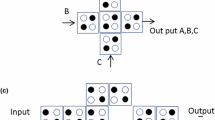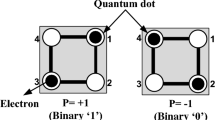Abstract
Quantum-dot cellular automata (QCA) technique is one of the emerging and promising nanotechnologies. It has considerable advantages versus CMOS technology in various aspects such as extremely low power dissipation, high operating frequency and small size. In this paper, designing of a one-bit full adder is investigated using a QCA implementation of Toffoli and Fredkin gates. Then, a full adder design with reversible QCA1 gates is proposed regarding to overhead and power savings. Our proposed full adder design is more preferable when considering both circuit area and speed. The proposed design uses only two QCA1 gates and maximizes the circuit density and focuses on a layout of the circuit which is minimal in using QCA cells.















Similar content being viewed by others
Explore related subjects
Discover the latest articles, news and stories from top researchers in related subjects.References
Landauer, R.: Irreversibility and heat generation in the computing processes. IBM J. Res. Dev. 5, 183–191 (1961)
Huang, J., Metra, Ma, X., Metra, C., Lombardi, F.: Testing reversible 1D arrays for molecular QCA. In: Proceedings of the 21st IEEE International Symposium on Defect and Fault-Tolerance in VLSI Systems, pp. 71–79 (2006)
Bennett, C.: Logic reversibility of computation. IBM J. Res. Dev. 17, 525–532 (1973)
Gupta, P., Jha, N.K., Lingappan, L.: test generation framework for combinational quantum cellular automata circuits. IEEE Trans. VLSI Syst. 15(1), 24–36 (2007)
Askari, M., Taghizadeh, M.: Logic circuit design in nano-scale using quantum-dot cellular automata. Eur. J. Sci. Res. 48(3), 516–526 (2011). ISSN 1450–216X
Hennessy, K., Lent, C.S.: Clocking of molecular quantum-dot cellular automata. J. Vac. Sci. Technol. 19(5), 1752–1755 (2001)
Tahoori, M.B., Huang, J., Momenzadeh, M., Lombardi, F.: Testing of quantum cellular automata. IEEE Trans. Nanotechnol. 3(4), 432–442 (2004)
Ma, X., Huang, J., Metra, C., Lombardi, F.: Reversible and Testable Circuits for Molecular QCA Design. Northeastern University, ECE Department, Internal report (2007)
Amlani, I., Orlov, A.O., Snider, G.L., Lent, C.S.: Demonstration of a six-dot quantum cellular automata system. Appl. Phys. Lett. 72(17), 2179–2181 (1998)
Orlov, A.O., Amlani, I., Bernstein, G.H., Lent, C.S., Snider, G.L.: Realization of a functional cell for quantum-dot cellular automata. Science 277, 928–930 (1997)
Walus, K., Jullien, G.A., Dimitrov, V.S.: Computer arithmetic structures for quantum cellular automata. In: Proceedings of Asimolar Conference (2003)
Ma, X.: Physical/biochemical inspired computing models for reliability Nano-technology systems. Computer Engineering Dissertations (2008). Paper 2. http://hdl.handle.net/2047/d10017859
Kyosun, K., Kaijie, W., Ramesh, K.: Quantum-dot cellular automata design guideline. IEICE Trans. Fundam. Electron. Commun. Comput. Sci. E89–A(6), 1607–1614 (2006)
Toffoli, T.: Reversible Computing. MIT Laboratory for Computer Science, Technical Report MIT/LCS/TM-151, Feb (1980)
Maslov, D., Dueck, G.W.: Synthesis of Fredkin-Toffoli reversible networks. IEEE Trans. VLSI (2004)
Mohammadi, M., Eshghi, M.: Heuristic Methods to use don’t cares in automated design of reversible and quantum logic circuits. Quantum Inf. Process. 7(4), 175–192 (2008)
Maslov, D., Dueck, G.W.: Garbage in reversible design of multiple output functions. In: 6th International Symposium on Representations and Methodology of Future Computing Technologies, Trier (1980)
Mohammadi, M., Eshghi, M.: On figures of merit in reversible and quantum logic designs. Quantum Inf. Process. 8(4), 297–318 (2009)
Wang, W., Walus, K., Jullien, G.A.: Quantum-dot cellular automata adders. IEEE-Nano Third IEEE Conf. Nanotechnol. 1, 461–464 (2003)
Wang, W., Zhang, R., Walus, K., Jullien, G.A.: A method of majority logic reduction for quantum cellular automata. IEEE Trans. Nanotechnol. 3(4), 443–450 (2004)
Walus, K., Schulhof, G., Jullien, G.A.: High level exploration of quantum-dot cellular automata. In: Proc. Conf. Signals, Systems, and Computers, pp. 7–10, Nov (2004)
QCA Designer [Online]. Available: http://www.mina.ubc.ca
Author information
Authors and Affiliations
Corresponding author
Rights and permissions
About this article
Cite this article
Mohammadi, Z., Mohammadi, M. Implementing a one-bit reversible full adder using quantum-dot cellular automata. Quantum Inf Process 13, 2127–2147 (2014). https://doi.org/10.1007/s11128-014-0782-2
Received:
Accepted:
Published:
Issue Date:
DOI: https://doi.org/10.1007/s11128-014-0782-2




